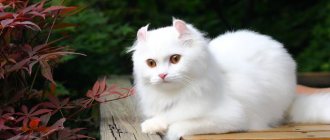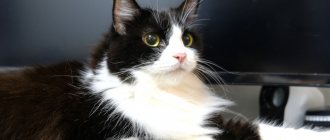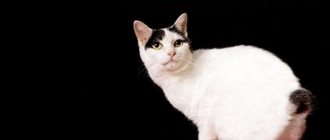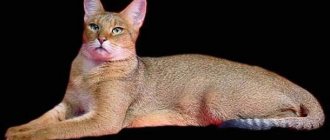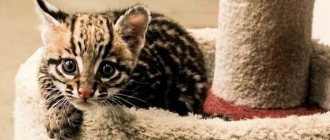Description and features
These cats are similar in color to a Siamese or Thai cat. They are characterized by the so-called point color. That is, the whole body is of a lighter tone than its protruding parts - the muzzle with ears, paws and tail. They are colored much more intensely, for which they received the name “color point” - “color points” (from English “colored dots, marks”).
This coloring depends on temperature; warmer areas of the body produce less color pigment, so they are lighter than prominent cold ones. Blue eye color is usually associated with the point color, apparently due to the lack of melanin, both in the main color of the coat and in the iris of the eye. It turns out that the blue eyes that adorn these cats are actually colorless, the blue tint gives them the effect of light refraction.
Our cat's fur is not long, without undercoat, smooth and shiny, a little like mink fur. Moreover, the main color can be several shades: beige, cream, light gray, smoky, pink, pastel. The body is slender, graceful, but strong and muscular. The body shape is closer to rectangular, the limbs are of medium length, the “slippers” on the paws are wide.
The main feature of such an animal is a short tail. The structure of the tail is unique to each cat and is never repeated. It is all twisted, as if it had been broken and put back together for a long time. All the “fractures” are not visible under the fur, but you can feel them with your hands. There is a legend associated with this tail.
They say that the ancestors of such cats lived in the ancient temples of Siam. They were valued for their loyalty, courage, intelligence and oriental “judgment.” The Siamese courtiers protected the princesses from evil spirits, and also took care of their treasures and accompanied them everywhere, including for bathing. The girls took off their jewelry and hung it on the cats' tails, since they had a short and curved one.
Another distinctive feature is that the claws on their hind legs are not “hidden” in the pads; when walking, the cat taps them on the floor, clattering like a big dog. These creatures are very clean and take a long time to do their “toilet”. By the way, they are also capable of teaching you order.
Many Mekongs, seeing scattered toys or other things, show obvious displeasure and may begin to “scratch” this object from an inappropriate place. Better hide it in the closet right away! The character of the Mekong Bobtail can be called “golden”.
They are receptive to learning, loyal, courageous, playful. Behaviorally closer to dogs. They are even able to guard the house; when a stranger appears, they emit a “growl,” become wary, and keep him in their field of vision for a long time until he “passes the test.”
This cat can talk, you just need to learn to understand him. But he is not intrusive, not clingy like Thai cats, and with dignity draws attention to himself when he needs it. Mekongs are not fans of using their claws; they do not scratch. If you manage to anger him, he will bite you. Literally follows the owner's heels. He can even bring him things and walk him on a leash. An affectionate cat with the character of a dog.
He may well occupy himself, but he will always watch you. You are his closest friend. The cat may be left alone for a while, but do not think that he does not worry about your absence, he just has a calm disposition. The cat communicates well with small children, understands them, plays affectionately, sometimes tolerates them, but is always friendly.
The Mekong Bobtail in the photo can make you fall in love at first sight. Expressive large and slightly slanted eyes, wide ears, delicate silky fur, thick paws, a charming tail, a graceful pose - all this makes the Mekong an almost perfect creature. Each individual part is beautiful, and the whole animal so satisfies our aesthetic taste that we are involuntarily moved by looking at it.
Oriental shorthair cat
- Height: 23-28 cm
- Body weight: 3.6-4.6 kg
- Lifespan: 12-15 years
- Temperament: Curious, outgoing, affectionate, intelligent, loyal and extroverted
Oriental Shorthair cats were created by crossing Siamese cats with other domestic cat breeds. The goal was to maintain the sleek and slender shape of Siamese cats while offering a much wider selection of coat colors and patterns. Today there are approximately 300 color combinations .
Orientals are easily recognized by their slender and muscular build, long neck, angular face with almond-shaped eyes and large ears.
Although their appearance is unusual and many are unfamiliar with these felines, Oriental Shorthairs are not as rare as other exotic cat breeds such as the Khoa Mani or Japanese Bobtail.
These cats are famous for their good-natured, sociable, inquisitive and playful nature. Orientals love to be around people and furry friends. They are always talkative and make an unusual cry, similar to a horn. They meow when they want something or want to know what you are doing and where you are.
Kinds
There can be only one type of purebred cat according to the standard, but the colors are different. Among the Mekong, the most common options are:
- Seal point - cream color with black-brown points.
- Red (red-point), quite rare - white-pink color with “brick” (fiery red) points.
- Tortie – only found in Mekong “girls”, the highlight is that light spots are generously scattered throughout the pointing cat’s coat.
- Point chocolate (chocolate-point) – snow-white coat with dark chocolate paws, nose, ears and tail, lilac eyes.
- Blue (blue-point) – the main color is silver, the points are pink-blue.
- Tabby (black, red) - various color variations, the main thing is that the “pattern” in the form of the letter “M” on the face must be clear.
Now they are breeding golden and lilac colors, there are already good results. In addition to the Mekong, there are several other types of bobtails:
- Kuril cats are the homeland of the Kuril Islands, they have lived there for at least 200 years, they have a lot in common with Siberian cats (thick fur, some types of color, habits). The hind legs are higher than the front legs. Weight reaches 8 kg.
- Japanese - their ancestry began in the 16th century, they say that they arrived in Japan from India. They were officially registered as a breed in 1990. In Japan, they are called “hello cats” and are depicted with a raised front paw. And painters conventionally drew the tail in the form of a chrysanthemum. The coat is smooth, silky, there is little fluff, the tail looks like a “hare”. The pussy itself is very elegant in appearance.
- American ones are the only “short-tailed” species whose ancestors are precisely known and officially recognized, down to their names. Their tail looks like a brush. Some of them have tassels on their ears. The “Americans” have long hair and weigh up to 7-8 kg.
- Karelian - were bred on the territory of Karelia and Ladoga. They were created by Russian breeders, using local individuals with short tails as a basis. Perhaps their ancestors were Norwegian forest cats. The head is triangular, the eyes are rarely blue, usually lemon yellow.
Singapura cat
- Height: 16-21 cm
- Body weight: 1.8-3.7 kg
- Lifespan: 11-15 years
- Temperament: energetic, outgoing, affectionate, friendly and curious
In their native Singapore, they are elevated to the status of a national treasure. There, Singapura cats are nicknamed “Kutsinta,” which translates to “love cat” or “the one I love.” Geneticists suggest that this breed shares ancestry with Siamese, Abyssinian and Burmese cats.
The Singapore cat is included in the Guinness Book of Records as the smallest breed of domestic cat.
Their short coat is usually ivory in color with dark brown markings. They are sociable and interactive cats that remain curious and playful long after they reach adulthood. Singapura cats are also incredibly assertive and talkative.
Breed standards
Until 2000, all point bobtail cats were called Thai. In 2003, this breed was officially recognized internationally. And in 2004 in Germany it received the name Mekong bobtail. The breed standard corresponds to the Thai cat, only without a tail. Therefore, it is sometimes called the Mekong Thai Bobtail . It must meet the following parameters:
- usually exactly repeats the Thai pointing color;
- The “broken” short tail consists of several vertebrae; according to the standard, three are allowed. The total length of the “pompom” should be no more than ¼ of the body length. The first “bending fracture” must be at the base of the tail;
- the head is round, the upper part is almost flat, the size of the head is proportional to the body, the chin is clearly defined;
- the eyes are large, oval, blue or blue, slightly elongated towards the temples in an oriental manner;
- the nose is straight, with a hump;
- the ears are wide, set high, with thick bases and rounded ends;
- medium size, body without weights, legs ending in thick rounded paws;
- soft, short wool has no undercoat, its presence is considered a breed defect;
- The female weighs from 3.5 kg, the male can reach 5 kg.
Pros:
- Good hunters, their character does not change with age.
- Temperament is playful and affectionate. They love company, warmth and walks.
- Not susceptible to genetic diseases.
- They live long enough.
Minuses:
- Kittens are expensive.
- It is difficult to find a decent nursery.
- The rarity of the breed, the difficulty of finding a pair for “marriage”.
The price of a Mekong Bobtail kitten is from $200. A cat is more expensive than a cat. The price is also influenced by the popularity of the nursery, pedigree, color, veterinary care and many other factors. The cost of a top-class purebred animal can reach $700 or more. Important advice: when choosing a Mekong Bobtail nursery , be sure to check the number of awards, documents, and look at reviews about it.
Burmese cat
- Height: 25-31 cm
- Body weight: 2.8-6.3 kg
- Lifespan: 9-13 years
- Temperament: active, people-oriented, friendly, sociable, intelligent, affectionate and demanding
The ancestors of Burmese cats come from Burma (now Myanmar). There are two varieties: American and European. The European species (sometimes called the "traditional") is more slender, with a wedge-shaped head, small pointed ears, and almond-shaped eyes. Meanwhile, the American (or "modern") Burmese is noticeably stockier, with a wider head, ears with a wider base, and eyes that are much rounder and more expressive.
Most Burmese cats trust strangers and make friends easily . If you often have guests over, this kitty's outstanding social skills are sure to make a splash!
These magnificent cats are direct descendants of Siamese cats, which explains their chatty nature; however, their voices are softer and less demanding. Like their cousins, Burmese cats are playful, energetic, and very intelligent. They are very sociable and love to cuddle. In fact, these kittens are so affectionate that they are called the “ideal companion cats .
Nutrition
If you decide to feed your cat regular food, do not add salt or seasonings to his food, take care of his kidneys. They benefit from boiled and raw boneless chicken, lean beef or pork, milk and offal. Some cats love raw and boiled liver. Sometimes cats prefer kefir instead of milk.
It happens that they like to feast on olives, give them only pitted ones, and no more than 2-3 per week. You can't give fish from the river, there are too many bones and salt there. We decided to pamper him with fish - boil the sea fish, separate it from the bones and offer it to your pet. Buy vitamins and other supplements at pet stores that will help your cat cope with hair loss and stool, and provide the required amount of fiber.
Dry food is healthier, all microelements are balanced, but you only need good premium food. And it's not cheap. In addition, it should not be taken simultaneously with natural food. Here you have to choose - either food or regular food. And don’t add any vitamins on your own, everything is in the food. The most important thing is to remember to give your cat water. Be sure to make sure the drinking bowl is clean and full of water.
Babies can be fed cottage cheese and kefir, and after 4 months, gradually switch to the adult menu. When walking with your Mekong, pay attention to what herbs he chooses to munch on. You can sometimes bring him a small bunch of blades of grass on your way home from work. Better yet, plant special grass for the cat.
There is a delicate moment in feeding a domestic predator - a mouse. These cats are good hunters, they catch mice and even rats. Teach your cat not to eat rodents, but simply to “smother” them. Someone could have already poisoned the mice, and your pet will accidentally suffer.
Turkish Angora
- Height: 23-35.5 cm
- Body weight: 3.7-6.8 kg
- Lifespan: 12-18 years
- Temperament: good-natured, sociable, playful and talkative
With its high intelligence and gorgeous white fur, it's easy to see why the Turkish Angora is a national treasure in its native country. For a time, these magnificent, intelligent, graceful cats were considered deaf and were so actively used in crossbreeding to create the Persian breed that they almost became extinct.
Turkish Angoras are descended from African wild cats. And this is the only domestic cat kept in Ankara zoos .
White fur is traditionally the most popular color of Turkish Angoras, but they can also be found in black, tan, brown and gray, as well as tabby, tortoiseshell and bi-color variations. The Turkish Angora is very intelligent. They are incredibly social cats who develop strong bonds with their family members. They happily accept other cats and dogs, and their naturally domineering nature quickly makes them dominant in the home menagerie.
Reproduction and lifespan
A Mekong Bobtail cat the first signs of interest in the other sex as early as 4 months, when the first heat comes. If you want to get healthy kittens, wait until estrus 3; before that, the “girl’s” body may not be able to cope with pregnancy. A pussy that is too young cannot bear fruit. Pregnancy lasts 63 days.
Mekong Bobtail kittens are sociable and very active. They are completely “immersed” in domestic relationships. They are interested in everything, they are inquisitive. When choosing a kitten, look at its surroundings. It absorbs the atmosphere like a sponge. If the house is clean and tidy, the mother is well-groomed and calm, you can start choosing a new friend.
By the way, Mekong cats are very responsible and careful mothers during the feeding period. At this moment, they try not to let even their beloved owner near the children. But then the father will take care of the upbringing, he will give them life skills - going to the cat litter, trying new food.
And the parent only feeds and makes sure that order reigns in the upbringing. Otherwise, no one can avoid “cracks.” Still, she is the head of the family. They can produce offspring even in old age. They live up to 20-25 years.
Chinese Li Hua
- Height: 30-35 cm
- Body weight: 4.1-5.5 kg
- Lifespan: 12-15 years
- Temperament: Intelligent, independent, alert, active and friendly
The Chinese Li Hua, also known as the "dragon Li" and the "fox flower cat", is believed to have thrived in the wild for hundreds of years before being eventually domesticated. Today, she is admired for her unwavering devotion to her owners and loyalty to children.
The Chinese Li Hua was adopted by the Cat Fanciers Association only in February 2010.
This active cat breed can be taught tricks. The Chinese Li Hua is friendly to cats and dogs. She loves interactive toys and appreciates human attention. If you treat her politely and with respect, she will respond with affection and devotion.
Care and maintenance
They are not picky and do not require special conditions. Although no genetic diseases have been identified, no one is immune from common ailments. Don’t let them interact with street stray cats, don’t let them out alone, get vaccinated on time.
The eternal problem of an animal in the house is fur everywhere. This cat's coat does not shed or fall off. Brush him periodically, although this process will be more for pleasure and a ritual of communication. They are great at licking themselves. As already mentioned, it does not hide the claws on its hind legs. The owner must constantly cut them, but very carefully and not short, so as not to injure the animal.
Check and clean ears and teeth. Teeth are perhaps the only weak point of an animal. Buy special toothpaste and brush. Be patient and get him used to brushing his teeth. After a walk, inspect his paws; he might have picked up sharp small objects.
Remember that your pet must have a quiet and secluded private place. Your pet has the right to his space and sometimes wants to be alone, unlike many other breeds.
Turkish van
- Height: 25.4-35.6 cm
- Body weight: 4.5-9 kg
- Lifespan: 12-17 years
- Temperament: sociable, playful, active and intelligent
The Turkish Van originated in the area of the mountain Lake Van and is believed to have flourished away from human civilization for many centuries. These cats have a completely white body with multi-colored spots on the head and usually a solid tail of an identical shade. Surprisingly, this is not a white cat with colored spots, but on the contrary: the Turkish Van has one large white “spot” covering the entire body.
These felines are called "swimming cats" and love water and have waterproof coats. The Turkish Van will be happy to take part in water battles, play in the sink with the tap running, or simply enjoy a bath.
They have a slightly wedge-shaped head, medium-sized ears, and round eyes that are amber, blue, or a heterochromatic combination of both. Turkish Vans are incredibly intelligent, easy to train animals. Although these cats are affectionate towards their family members, they generally do not like hugs . Turkish Vans can lie next to you and will happily allow you to pet them, but they will not give in to your hands, preferring to be next to you rather than in your hands or lap.
Interesting Facts
- These cats have matriarchy. If you have purchased two kittens of different sexes, the owner will always be a cat. She will dominate, even if she is smaller in size.
- It is interesting that they meow only when communicating with a person; they do not make such sounds among themselves.
- Mekongs are sensitive to sharp sounds. If the TV is loud in the room and music is playing, they leave the room. Therefore, having got such a cat, you will inevitably live in peace and quiet.
- Blue-eyed cats see worse in the dark than their relatives with yellow or green eyes. They have almost no reflective pigment in the taptum (layer of the retina). Therefore, in the dark, the eyes of such pussies do not glow, reflecting the flash. You are unlikely to get the “burning eyes effect” in the photo.
- There are amazing stories when these furry friends protected their owner from a dog and even a snake. Most likely, such skills are rooted in their storied past. Mekongs are considered descendants of sacred temple cats. And they were hired there not only for their beauty and intelligence, but also for their courage. In addition, they have a peculiarity in their physique - the skin does not fit tightly to the subcutaneous tissues. Therefore, the bites of snakes, which often crawled inside the temple, fell where there were no blood vessels. Moreover, the cat itself could injure the snake with its teeth. She circled around the reptile for a long time, exhausting it, and when it lost its vigilance, it bit the neck.
Personality of the Mekong Bobtail
Mekong Bobtail cats are very inquisitive, so get ready for the pet to follow you everywhere, accompany you in all household chores, and sleep in your bed. Sociable animals make many amazing purring and cooing sounds, commenting on their own actions and responding to the owner’s remarks. At the same time, they are quite restrained and do not allow themselves to express their feelings violently. Representatives of this breed love to be interacted with, often saying their name.
Mekong cats have “dog-like” habits: they love to carry things in their teeth, are happy to carry out the “Fetch!” command, and always run to inspect and sniff the guest. In cases of forced self-defense, they often bite rather than use their claws. But due to its peaceful nature, it is not so easy to force your pet to defend itself. The Mekong Bobtail is patient with small children. These are loyal creatures that become attached to all family members and are well aware of their owner’s mood.
The breed gets along easily with other pets if they are also friendly. But before you keep fish, birds or rodents at the same time, you should think carefully, because cats have an incredibly strong hunting instinct. Mekong bobtails tolerate traveling in cars well, but each animal can have its own “speed limit”, if it is exceeded, the cat begins to meow loudly, informing the driver of discomfort. If you often travel in a car, you should accustom your pet to this method of transportation as early as possible.
If you acquire two animals of different sexes, the cat will take over the leadership of the pair. She will closely monitor that the cat fulfills parental responsibilities: accustoming the offspring to complementary foods, a scratching post, a tray, and licking them. In such a situation, the owner practically does not have to deal with these issues.
Do not lock the animal in a separate room. The Mekong Bobtail is perfect for any family and can easily be called a furry companion. Pets do not tolerate prolonged loneliness well, which must be taken into account when deciding to get a cat.
Raas
- Height: 29-36 cm
- Body weight: up to 6.8 kg
- Lifespan: 12-15 years
- Temperament: Playful, stubborn, energetic and independent
Raas is a breed of domestic cat that originated on the Indonesian island of Raas. Their physical characteristics are very similar to a wild jungle cat or leopard. These cats are larger than most other breeds. The raas has a square-shaped muzzle, a slightly pointed chin, erect ears, and dark green eyes.
There are many myths about them. One states that these felines have a sixth sense , and can only be kept by a certain group of people, such as clergy and community leaders. Another myth says that if a person decides to take a raas off the island, his luck will turn away.
Raas are energetic and playful, but seem to be afraid of humans and sometimes have difficulty adapting. However, it is quite possible to tame them, but you will have to be patient, since from time to time the Raas can be stubborn and grumpy.
Khao-mani
- Height: 25.4-30.5 cm
- Body weight: 3.6-4.5 kg
- Lifespan: 10-12 years
- Temperament: sociable, affectionate and courageous
First mentioned in classical Thai literature as early as 1350, khao mani, meaning “white gem,” immediately gained popularity. These light-eyed cats were prized by Thai aristocrats, considered sacred and protected by the ruling class for centuries.
The Khao Mani is one of the most expensive cat breeds in the world with a price tag of around $7,000-$11,000 . These rare cats are said to bring good luck to their owners.
These cats are sociable, curious and completely devoted to their family. Energetic and quite intelligent, Kao Mani love interactive games and quickly get along with children and other playful pets.
History of development
The ancestors of the Mekong Bobtail are Siamese. Despite the fact that the first mentions of animals with the Siamese color, but with a short and curved tail, were found already in the 20th century. and even before, the breed was not recognized for a long time. Cats with a broken tail were considered a waste.
Only at the end of the last century did breeders from Russia begin to seek recognition of the short-tailed Siamese as a separate species. The first standard was developed and adopted in the mid-90s. And it was finally adjusted and approved in 2004 in Germany. The breed received an official name and was classified as the Siamese-Oriental type.
